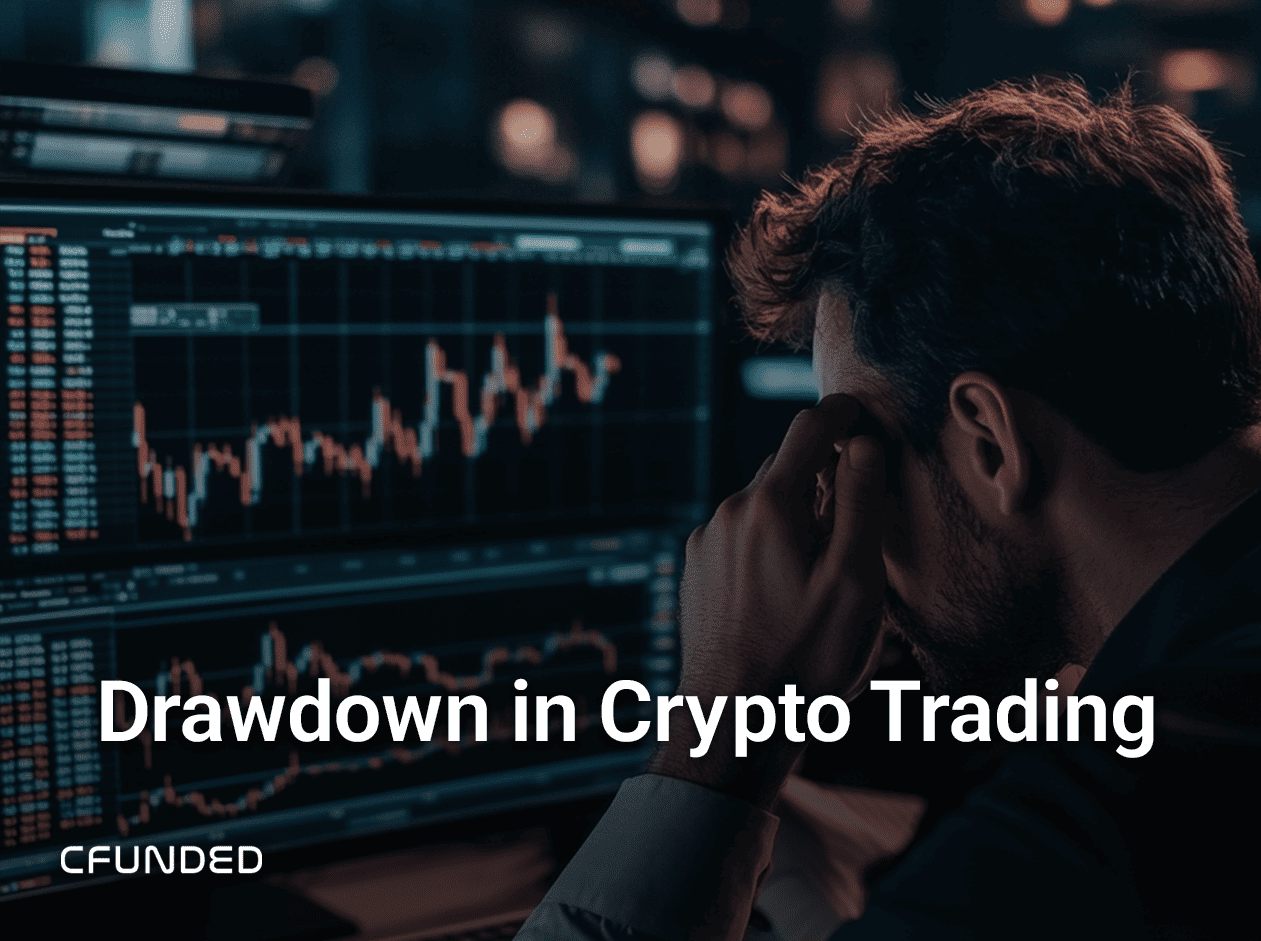Imagine this: your crypto portfolio is soaring, trades are hitting targets, and profits are flowing—until one sharp move in the market wipes out half your gains overnight. Sound familiar?
Welcome to the high-stakes world of crypto trading, where the potential for massive profits is rivaled only by the risk of sudden, gut-wrenching losses. This is where understanding one crucial concept—drawdown—becomes your greatest weapon for survival and long-term success.
Whether you’re a solo trader navigating the chaos or working with elite crypto prop trading firms like CFunded, learning how to manage drawdowns can save your account, your confidence, and your future in the markets.
This guide goes beyond the basics. We’ll break down what drawdown really means, why it matters more than you think, and how you can master it with smart, proven strategies.
Ready to protect your capital and trade like a pro? Let’s dive in.
What Is a Drawdown?
A drawdown refers to the reduction in the value of a trading account from its peak to its lowest point before a new high is reached. It is usually expressed as a percentage and serves as a key metric to evaluate the risk exposure and volatility tolerance of a trading strategy.
For instance, if your crypto portfolio decreases from $10,000 to $7,000, the drawdown is:
Drawdown = ($10,000 – $7,000) / $10,000 = 30%
The deeper the drawdown, the more difficult it becomes to recover. For example, a 30% drawdown requires a 43% return just to get back to breakeven. In crypto trading, where sharp price swings are routine, managing drawdowns is not a luxury—it’s a necessity.
Understanding Drawdowns
Drawdowns are more than just temporary losses—they are a barometer for your strategy’s resilience and your ability to withstand market pressure. Understanding drawdowns helps traders in several ways:
-
Quantifying Risk: It shows how much capital you’re actually putting at risk.
-
Assessing Strategy Viability: It helps measure whether your strategy is built for sustainability or quick gains.
-
Psychological Preparation: Knowing potential drawdowns in advance reduces emotional panic during live trading.
-
Setting Realistic Goals: Helps align profit expectations with acceptable levels of loss.
Many crypto prop trading firms, including CFunded, emphasize maximum drawdown (Max DD) as a critical factor when evaluating a trader. It’s not just about how much you can earn—it’s about how well you can protect capital under pressure.
Risk of Drawdowns
Drawdowns can be devastating if not controlled. Besides the financial loss, large drawdowns have a psychological impact that often leads to poor decision-making, overtrading, or abandoning a strategy too soon. Recovery becomes significantly harder with larger drawdowns:
-
A 10% drawdown requires an 11.1% gain to recover.
-
A 25% drawdown needs a 33.3% gain.
-
A 50% drawdown demands a 100% return just to break even.
As part of the funding model, CFunded and other top firms often implement strict drawdown limits. Traders must show discipline and consistency under real market conditions. Therefore, minimizing drawdown isn’t just smart—it’s a fundamental requirement for getting funded.
Risk for Retirees
Drawdowns can be particularly harmful for retirees or those living off passive income. These individuals often make regular withdrawals from their portfolios, and during periods of drawdown, this practice can lead to irreversible capital erosion.
In the crypto market—where price volatility is often extreme—retirees who are not careful can see their capital depleted faster than expected. This is why low-risk crypto trading strategies, capital preservation, and smaller position sizing are essential for anyone in or nearing retirement.
Even small drawdowns, when combined with ongoing withdrawals, can drastically shorten the lifespan of a retirement portfolio.
Example
Let’s break down a practical scenario to illustrate the concept of drawdown:
Imagine a trader begins with a $20,000 account in a crypto prop firm and experiences a decline to $14,000 after a series of losses or a single large failed trade.
Drawdown = ($20,000 – $14,000) / $20,000 = 30%
Even if the trader later grows the account back to $18,000, they haven’t fully recovered. The drawdown remains significant until the account surpasses the previous high of $20,000.
Many crypto prop trading firms, including CFunded, closely monitor such performance. A large drawdown—especially if it occurs quickly or without risk controls—may disqualify the trader, even if profits eventually follow.
What Is Drawdown in Crypto Trading?
In crypto trading, drawdown is particularly common due to:
-
High Leverage: Amplifies both gains and losses, often resulting in extreme drawdowns.
-
Low Liquidity: Especially in altcoins, slippage and rapid price movements can accelerate losses.
-
Sudden Market Moves: News, regulation, or social media influence can crash prices in minutes.
-
Emotional Overtrading: Fear, greed, and revenge trading contribute heavily to uncontrolled losses.
Despite this, drawdown management remains one of the most ignored skills by beginner crypto traders. Many traders focus solely on potential profits, forgetting that capital preservation is key to staying in the game long enough to win.
That’s why most crypto prop trading firms incorporate maximum drawdown thresholds in their funding challenges—to ensure traders know how to protect the downside as much as they pursue the upside.
Why Does Drawdown Matter?
Drawdown tells the real story behind a trading strategy. A trader with a 300% return might appear successful, but if that performance involved a 70% drawdown, the risk profile may be unacceptable for a prop firm.
Here’s why drawdown matters:
-
Longevity: Traders who control drawdowns survive longer in volatile markets.
-
Stability: A smooth equity curve is more attractive than one full of massive swings.
-
Professional Trust: Firms like CFunded prefer traders with predictable, controlled risk.
-
Capital Scaling: Drawdown control is essential for scaling your capital responsibly and sustainably.
Prop firms evaluate not only how much you make—but how safely you make it.
Strategies to Manage Drawdown
To thrive in the world of crypto trading—especially when applying to prop firms like CFunded—you must use disciplined strategies to manage drawdowns effectively:
1. Use Proper Stop-Losses
Always define your exit before entering a trade. Stop-losses help cap potential losses and prevent one bad trade from turning into a disaster.
2. Position Sizing
Only risk 1–2% of your account per trade. This ensures that even a losing streak won’t damage your overall capital significantly.
3. Avoid Overleveraging
While high leverage can seem tempting, it can also amplify losses beyond recovery. Most professional traders use low or moderate leverage—even in aggressive strategies.
4. Diversify Your Portfolio
Don’t concentrate your entire risk on a single asset or trade. By diversifying across coins, sectors, and timeframes, you reduce exposure to isolated events.
5. Backtest and Forward Test
Test your trading strategy under different market conditions to understand its expected drawdown. Platforms like TradingView and MyFxBook offer great tools for this purpose.
6. Stay Emotionally Detached
Your worst trading decisions often happen when emotions take over. Maintain discipline by following your plan, using alerts, and avoiding revenge trades after losses.
How Cfunded Helps Manage Drawdowns
Trading platforms like Cfunded provide tools to minimize drawdowns and optimize trading performance. Key features include:
- Access to Funded Accounts: Trade with professional-grade capital while adhering to strict risk management rules.
- Educational Resources: Learn sustainable trading strategies to reduce losses.
- Advanced Trading Tools: Analyze trades effectively and monitor performance metrics.
- Supportive Community: Connect with like-minded traders to share insights and strategies.
Conclusion
Understanding drawdown in crypto trading isn’t optional—it’s a critical pillar of risk management. Whether you’re managing your personal crypto investments or applying to top crypto prop trading firms like CFunded, your ability to manage drawdowns will directly determine your long-term success.
A great trader doesn’t just make money—they know how to protect capital, stay consistent, and adapt their strategy when things go wrong.
Profits are exciting—but survival is the real victory.




